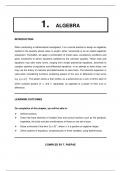Tentamen (uitwerkingen)
Test Bank for Accounting Information Systems: Connecting Careers, Systems, and Analytics 1st Edition by (Savage/Brannock/Foksinska) ||Complete A+ Guide
- Vak
- Instelling
- Boek
Test Bank for Accounting Information Systems: Connecting Careers, Systems, and Analytics 1st Edition by (Savage/Brannock/Foksinska) ||Complete A+ Guide
[Meer zien]





